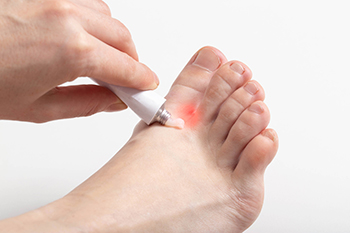
Athlete's foot, also known as tinea pedis, is a fungal infection that affects the skin on the feet, often starting between the toes. It thrives in warm, moist environments like locker rooms, public showers, and sweaty shoes. Causes include walking barefoot in these type of areas or wearing damp footwear for extended periods of time. Symptoms of athlete’s foot consist of itching, redness, peeling, and cracking skin, typically between the toes, and sometimes blisters or sores. In severe cases, the infection can spread to the toenails or other parts of the body. Diagnosis is usually made based on the appearance of the skin, but a podiatrist may take a skin scraping to confirm the presence of fungus. In persistent cases of athlete’s foot, prescription-strength antifungals may be needed. If you have athlete’s foot that is not clearing up, it is suggested that you schedule an appointment with a podiatrist for treatment.
Athlete’s Foot
Athlete’s foot is often an uncomfortable condition to experience. Thankfully, podiatrists specialize in treating athlete’s foot and offer the best treatment options. If you have any questions about athlete’s foot, consult with Jon McCreary, DPM from Fort Worth Podiatry. Our doctor will assess your condition and provide you with quality treatment.
What Is Athlete’s Foot?
Tinea pedis, more commonly known as athlete’s foot, is a non-serious and common fungal infection of the foot. Athlete’s foot is contagious and can be contracted by touching someone who has it or infected surfaces. The most common places contaminated by it are public showers, locker rooms, and swimming pools. Once contracted, it grows on feet that are left inside moist, dark, and warm shoes and socks.
Prevention
The most effective ways to prevent athlete’s foot include:
- Thoroughly washing and drying feet
- Avoid going barefoot in locker rooms and public showers
- Using shower shoes in public showers
- Wearing socks that allow the feet to breathe
- Changing socks and shoes frequently if you sweat a lot
Symptoms
Athlete’s foot initially occurs as a rash between the toes. However, if left undiagnosed, it can spread to the sides and bottom of the feet, toenails, and if touched by hand, the hands themselves. Symptoms include:
- Redness
- Burning
- Itching
- Scaly and peeling skin
Diagnosis and Treatment
Diagnosis is quick and easy. Skin samples will be taken and either viewed under a microscope or sent to a lab for testing. Sometimes, a podiatrist can diagnose it based on simply looking at it. Once confirmed, treatment options include oral and topical antifungal medications.
If you have any questions, please feel free to contact our office located in Fort Worth, TX . We offer the newest diagnostic and treatment technologies for all your foot care needs.
